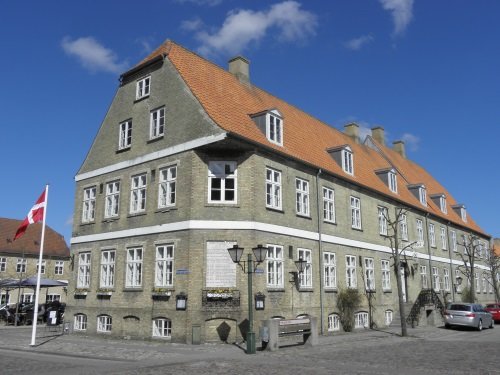In southern Denmark lies a small town where in 1773 the Protestant Herrnhutter started a new church community. Their town plan and characteristic light brick houses have been preserved until today. It is a quiet place where linden trees line the streets on both sides, and where the huge wooden Moravian Church is still the focal point.
Christiansfeld a Moravian Settlement
is one of no less than three Danish nominations for 2015.

|
|
The Moravian hotel
|
The Herrnhutter or Moravian Brethren are a Protestant denomination originating from Bohemia, whose members settled in Saxony (now Germany) after being persecuted in the Catholic Habsburg lands. There they established a new village called Herrnhut, and from that place they started the first large-scale Protestant missionary movement. They sent their missionaries to all parts of the world. Denmark (or more accurately: the Dano-Norwegian Empire of that period) was one of the first places they went to.
Christiansfeld is an easy site to visit on the way between the
Jelling WHS
and the
Hamburg Speicherstadt TWHS
, and well worth a short stop. I was there in April 2013 and I walked Christianfeld’s picturesque main streets in about half an hour. It’s a small town that has preserved its planned layout and original architecture well. The straight roads still are lined with rows of linden. The sturdy houses are made of light coloured bricks. The building style is very sober, in accordance with the Moravian principles. The undoubted highlight of the town is the huge wooden Moravian Church, located at a fine small square that would not be out of place in Holland. No wonder, as the Dutch town of Zeist is said to have been used as an example for Christiansfeld’s construction.

|
|
Moravian Church of Christiansfeld
|
After my visit in 2013, I believed that this nomination would need a brilliantly written nomination file to convince ICOMOS and the WHC. Two years later we know that it has received a
positive recommendation for inclusion by ICOMOS
, so you may guess that the Danes have succeeded in doing so. The dossier however is not without its flaws, and we might see a transformation of this single ‘group of buildings’ into a transnational serial site over the coming years.
We have discussed the Moravian Heritage Network on our
Forum
before: it is (or was?) a network of Moravian settlements in Northern Ireland, the USA, South Africa, Germany and The Netherlands. They have worked together for some years on a joint nomination, but Christiansfeld has chosen to go ahead on its own as the others are not ready yet and “because Christiansfeld is the best remaining example anyway”.

|
|
Church square with typical trees and houses
|
In its evaluation, ICOMOS does not fully agree with this conclusion: it may be the best preserved in Europe, but the serial nature of these church colonies around the world must be stressed. While the OUV of Christiansfeld is enough to earn a place on the WH List, the AB urges other countries (outside of Europe) to add serial sites in the coming years. Towns in the US may qualify (such as
Bethlehem, Pennsylvania
), but maybe also places in South Africa, Tanzania, Nicaragua or the Danish West Indies. So it will be interesting whether we will see any 'Moravian heritage' activity on future Tentative Lists.



